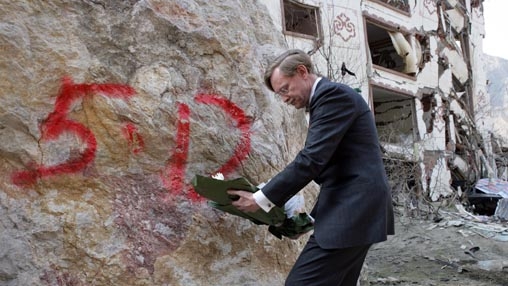December 15, 2008 - More than half of Beichuan’s 20,000 residents died in the Wenchuan Earthquake seven months ago.
Today, the collapsed town lies buried in mud, deemed too risky to rebuild. The only people in sight are passing through from mountain villages on their way to more seismically stable towns.
World Bank President Robert B. Zoellick went to Beichuan yesterday to lay flowers in memory of the more than 80,000 who were killed or went missing in the May 12 earthquake. The town of Beichuan itself is slated to become a memorial and will never be rebuilt, say Chinese authorities.
“The May 2008 earthquake that devastated Sichuan, Gansu and Shaanxi left a terrible scar on China’s landscape and the psyche of the Chinese people. The rebuilding and healing process continues, and I hope to better understand what can be done to help the people of Sichuan recover,” Zoellick said in a press release as he was leaving for China.
“China’s rebuilding efforts offer many lessons the World Bank Group can share with our global clients who are also at risk from natural disasters.”
Elsewhere in the earthquake zone a massive recovery effort has begun.
Heavily damaged Leigu township now has transitional housing—accommodating many survivors from Beichuan—as well as a school and clinic. A small handicraft factory has been set up in a temporary building and young women are being taught to make traditional embroidered clothing so that they can start to earn a living again. Some permanent buildings have been built and people are beginning to get their lives back on track, says World Bank senior urban environment specialist Mara Warwick, who is leading the Bank’s work in response to the Wenchuan Earthquake.
She says the earthquake’s impact on the landscape and the lives of local people who have lost children and family members has been “very sobering.”
“There has been a huge amount of trauma. Many people have suffered tremendous personal tragedy.”
33 Million Affected
The Chinese government estimates the 8.0 earthquake and its 30,000 significant aftershocks have affected more than 33 million people. Some 69,000 were killed, 375,000 injured, and 18,000 remain missing.
The quake caused $123 billion in losses in Sichuan, Gansu and Shaanxi provinces, destroying 34,000 km of highway and damaging 1,263 reservoirs. Some 7,444 schools and 11,028 hospitals and clinics collapsed, and more than 4 million rural and urban houses were destroyed.
The government has put in place a $147 billion reconstruction master plan to help the area recover over the next three years. Reconstruction is now part of $586 billion stimulus package unveiled in November in the wake of the global financial crisis.
The government is also looking at broadening the investment that will be made in these areas over the next three years “in recognition of the fact that simple reconstruction in these areas isn’t going to be enough, and that they also need to stimulate the economy at the same time, especially to create jobs locally,” says Warwick.
Though hard-hit Sichuan Province is considered the “rice bowl” of China because of its high levels of agricultural productivity, many of the earthquake-affected areas of Sichuan are relatively poor. Gansu Province, which was also affected, is the second poorest province in the country.
Millions in the earthquake zone remain vulnerable to falling back below the poverty line, according to the Chinese Ministry of Commerce.
World Bank Help
In the aftermath of the earthquake, the Chinese government swiftly sought information on international best practices in earthquake response. The first meeting with the World Bank on earthquake response and recovery occurred the day after the earthquake with Chinese officials who were already in Washington, says Warwick.
The World Bank supported China with an initial $1.5 million grant through the Global Facility for Disaster Reduction and Recovery (GFDRR). This grant has helped to provide emergency tents and will provide technical assistance for the reconstruction effort.
The Bank also mobilized a team of international experts, many with experience in other recent earthquakes such as in Turkey and Pakistan.
These international experts met with Chinese counterparts in the central and local government who are charged with planning the reconstruction efforts. The government’s reconstruction masterplan reflects many of major lessons presented by experts from other countries, the Bank and the United Nations, notes Warwick.
“It’s been a very successful discussion and collaboration,” she says.
The World Bank has recently also provided a Global Environment Facility (GEF) grant of US$1 million to support assessment of potential chemical contamination from industries affected by the earthquake.
The World Bank’s private-sector arm International Finance Corporation is also helping small and medium-sized businesses in the Chengdu area get much-needed financing in the aftermath of the earthquake.
$740 Million Project Planned with Bank
The Chinese government has also asked the Bank to partner on a $740 million project to restore infrastructure, health and education services in several counties and municipalities in Sichuan and Gansu.
Under the project, up for approval by the Bank’s Board in January, $710 million in financing from the Bank would be used to, among other things, reconstruct roads and bridges, water supply and sanitation, solid waste collection and disposal, and drainage, and to strengthen flood control, and restore health centers and schools.
“The Chinese government has planned a very big reconstruction program that needs to be implemented in a relatively short period of time,” says Warwick. “The Chinese government is interested to have international organizations involved in order to learn from international good practice in disaster recovery and mitigation, build local government capacity to manage the reconstruction program, and put in place robust fiduciary and safeguards controls.”

